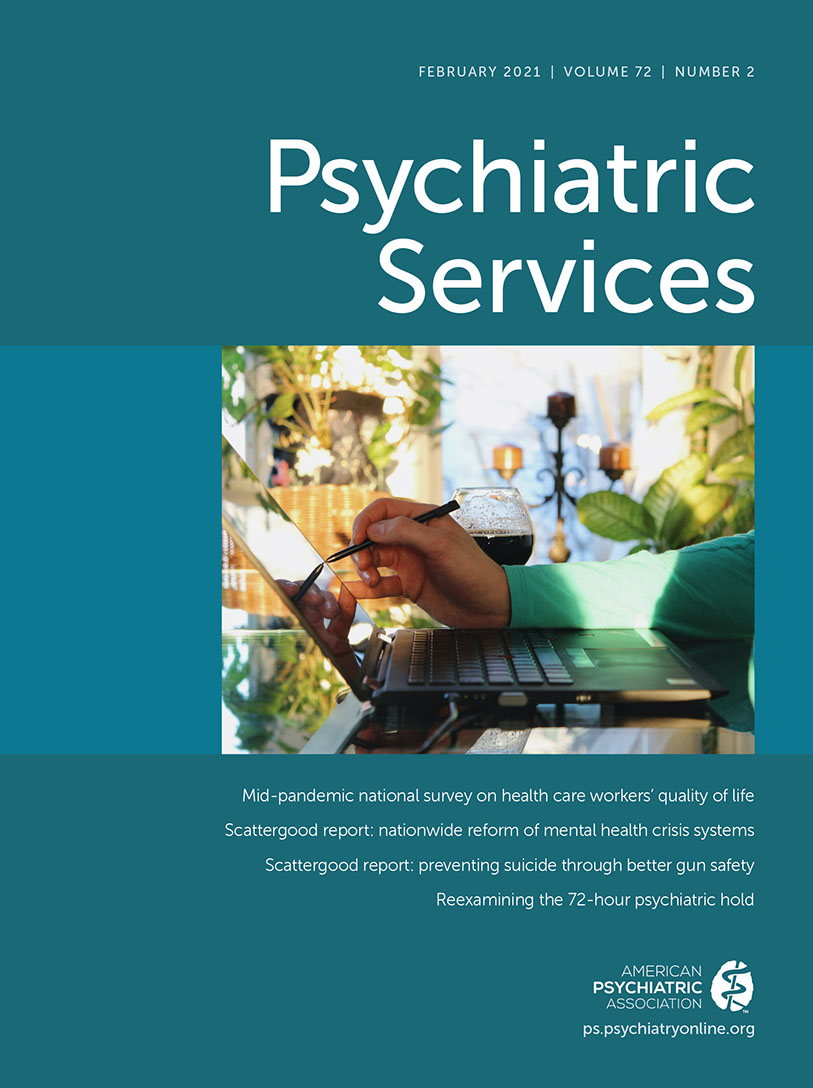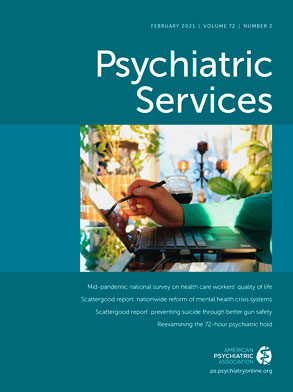Specialty mental health treatment facilities form the foundation of the mental health treatment system for individuals with acute mental health needs and severe mental illness (
1). These facilities provide a broad range of evidence-based services spanning the continuum of care from outpatient services to partial and inpatient hospitalization. In addition to providing psychotropic medication management and a range of psychotherapeutic approaches (in individual, group, or family settings), some of the key services they provide include crisis services, suicide prevention services, substance use treatment, and an array of other services, including telemedicine, integrated health services, peer support, case management, and housing and employment support (
1,
2). This broad range of available services comprises the core tenets of mental health treatment provided in the community. Given their crucial role for individuals across the recovery spectrum, specialty mental health treatment facilities need to continually adapt to the changing behavioral health needs of their communities.
Some studies have investigated changes over time in specific services provided in community-based mental health settings. For example, the proportion of facilities offering telepsychiatry, that is, the remote provision of mental health services, has almost doubled in recent years (
3), whereas the proportion of facilities offering assertive community treatment (ACT), a highly intensive 24-hour multidisciplinary clinical team approach for individuals with serious mental illness living in the community, has declined (
4). However, how the full range of treatment services in community-based mental health facilities has changed over the past decade has not been examined.
Significant large-scale policy changes and clinical events have occurred during this time frame that individually or collectively may have influenced the provision of behavioral health services in specialty mental health treatment facilities, including Medicaid expansion and behavioral health epidemics. For instance, the U.S. suicide rate increased 28% between 1999 and 2016 (
5), and the opioid overdose rate increased almost sixfold since 1999 (
6), each resulting in approximately 45,000 deaths annually (
6,
7). In response, federal and state agencies have allocated additional resources to address both of these public health challenges (
8,
9). However, it remains unclear whether there have been changes to the broader landscape of treatment service offerings in specialty mental health facilities and in the context of the increased attention to and investment in addressing the suicide and opioid epidemics. In this study, we used national data to describe the extent to which key service offerings in the specialty mental health treatment infrastructure have changed in recent years.
Methods
We used data from the National Mental Health Services Survey (N-MHSS), which was first conducted in 2010 and most recently in 2017 (
1), to descriptively analyze services provided at U.S. mental health facilities at these two time points. The N-MHSS is an annual survey of facility directors at all known public and private mental health treatment facilities in the United States that provide primarily mental health services (rather than substance abuse services or primary care). Facilities operated by the U.S. Department of Defense, jails and prisons, and independent practitioners or small groups are excluded from the N-MHSS. It is the only source of national and state-level data on both publicly and privately operated mental health care facilities in the United States. In 2010 and 2017, 53.4% and 90.0% of respondents completed the survey online, 24.4% and 3.0% via mail, and 22.2% and 8.0% by phone, respectively. The response rate was 91.2% in 2010 and 87.1% in 2017 (
1).
Service availability was analyzed separately for outpatient facilities and for inpatient facilities (including inpatient, partially inpatient, and residential facilities). If facilities provided both inpatient and outpatient services, they were classified as outpatient facilities to compile information about the least restrictive service venues. In 2010, the 50 U.S. states and Washington, D.C. had 6,505 responding outpatient facilities and 2,038 inpatient facilities. In 2017, there were 8,805 responding outpatient facilities and 2,698 inpatient facilities.
We examined a range of behavioral health services to gain a broad understanding of how the service landscape has changed from 2010 to 2017. First, three measures were created to assess the availability of crisis services: psychiatric emergency walk-in services, crisis intervention teams (onsite or offsite), and suicide prevention services. Psychiatric emergency walk-in services are those with staff specifically trained to provide psychiatric care, such as crisis intervention, in emergency situations on a walk-in basis. The presence of a crisis intervention team was determined with the question, “Does this facility offer a crisis intervention team that handles acute mental health issues at this facility and/or offsite?” (response options were yes or no). Finally, respondents were asked to indicate whether the facility had suicide prevention services (yes vs. no) if it offered services to accomplish any of the following aims: identify risk factors; educate staff to identify the signs of suicidal behavior and to use methods to detect suicide risk; and conduct assessment, intervention, and management of suicidal patients, including treatment of an underlying mental or substance use disorder and use of psychotropic medication, supportive services, and education (
1). Facilities that provide substance use treatment were also identified.
To characterize the treatment landscape more broadly, we assessed additional categories of services, including telemedicine services, integrated primary care services, case management services, intensive case management, ACT, peer services, housing services, supported employment, and supported housing (
1).
Analyses compared the availability of specific services over time by using unadjusted and adjusted relative risk (RR) ratios and 95% confidence intervals (CIs). (A table showing unadjusted RR ratios is in an online supplement to this article.) For the adjusted analyses, we used Poisson regression with a log link and robust standard errors to produce RR ratios in order to examine changes over time while controlling for facility ownership, age of treatment population, sliding fee scale availability, and insurance accepted. We used a generalized estimating equation framework to account for the nesting of facilities within states. Results were stratified for outpatient and inpatient/residential facilities. Line-item deletion was used, and only respondents with completed surveys were included in the final analysis. Because the data set is publicly available, the institutional review board of the University of Pennsylvania determined that this research did not constitute human subject research.
Results
More than four in 10 (41.8%) outpatient mental health treatment facilities offered psychiatric emergency walk-in services in 2010, compared with three in 10 (34.2%) in 2017 (
Table 1). In adjusted models, this change over time represented a 28% decline in the proportion of facilities that offered these services (adjusted RR [ARR]=0.81). When we examined the availability of an onsite or offsite crisis intervention team in outpatient mental health treatment facilities, we noted that this percentage declined from 58.8% in 2010 to 49.8% in 2017 (ARR=0.88). The percentage of outpatient mental health treatment facilities that offered suicide prevention services did not significantly change between 2010 (59.2%) and 2017 (58.7%).
The overall pattern of availability of crisis services was similar for inpatient, partially inpatient, and residential mental health treatment facilities. Specifically, the availabilities of psychiatric emergency walk-in services (ARR=0.80) and crisis intervention teams (ARR=0.80) significantly declined, and the availability of suicide prevention services did not significantly change between 2010 and 2017 (
Table 1).
The availability of services to treat substance use increased in mental health treatment facilities during the study period. Among outpatient mental health treatment facilities, the proportion offering substance use treatment increased from 54.3% in 2010 to 60.3% in 2017 (ARR=1.05). Among inpatient, partially inpatient, and residential treatment facilities, the percentage offering substance use treatment increased from 37% in 2010 to 41% in 2017 (ARR=1.09) (
Table 1).
During the study period, the availability of two services notably increased. The proportion of outpatient facilities offering telemedicine increased from 18.6% in 2010 to 34.1% in 2017 (ARR=1.66). In addition, the proportion of outpatient mental health treatment facilities offering peer services increased from 20.9% in 2010 to 26.9% in 2017 (ARR=1.32). The findings for inpatient facilities were similar in direction and significance for both of these services (
Table 1).
Finally, with the exception of integrated primary care services (which remained essentially the same during the period studied), the percentages of inpatient and outpatient facilities providing case management, intensive case management, ACT, supported employment, and supported housing significantly decreased.
Discussion
Between 2010 and 2017, the proportion of facilities providing suicide prevention services did not significantly change, and the proportion of facilities offering two key crisis services—psychiatric emergency walk-in and crisis intervention services—significantly declined, both of which are often used during acute psychiatric episodes, including deliberate self-harm or suicidality. These findings are surprising given that in 2010, the U.S. government declared that reducing the suicide rate and preventing suicide attempts were the top goals under the mental health status improvement section of Healthy People 2020 (
10). In that same year, the National Action Alliance for Suicide Prevention was formed to transform health systems and communities to reduce suicides by 20% (
11). Thus, our observations suggest that these policies may not have translated into significant changes in clinical practice. Future research should try to identify barriers and facilitators of the implementation of evidence-based crisis services in outpatient and inpatient mental health facilities.
In contrast to the declines in key crisis services, inpatient and outpatient mental health facilities provided substance abuse treatment at significantly greater proportions in 2017 than in 2010. Still, room for improvement remains because in 2017, only six of 10 outpatient mental health treatment facilities and less than half of inpatient, partially inpatient, and residential mental health treatment facilities offered substance use treatment. Given the high level of comorbidity between mental health and substance use disorders (
12) and the increased investment in substance use treatment in primary care, safety net settings (
13), additional policies that expand substance use treatment in specialty mental health clinics could improve accessibility of these services while also enhancing the integration of mental health and substance use treatment.
Between 2010 and 2017, the proportion of mental health treatment facilities providing telemedicine almost doubled, and the percentage of facilities that provided peer-support services also significantly increased. It is possible that the rise in telepsychiatry and peer services was related to the decline in crisis services in an attempt to implement more cost-effective treatment. Although previous studies have identified a role for peer specialists (
14) and telepsychiatry (
15) in suicide prevention, future research should compare the outcomes for patients achieved with these newer services with the outcomes of more long-standing evidence-based practices.
Several limitations should be noted. First, the N-MHSS is a voluntary self-report survey of mental health facilities. As with most surveys, some respondents did not respond to all items; still, the average per-item response rate was 98% in both 2010 and 2017. Moreover, the N-MHSS excludes facilities that primarily focus on substance abuse treatment. The findings reported here are specific to mental health facilities that also provide substance abuse treatment. It is important to note that it is an encouraging sign that more mental health facilities offer substance abuse treatment, suggesting that the system is beginning to accommodate the need for integrated treatment of comorbid mental health and substance abuse disorders. Finally, the structure of the data prevented us from tracking specific facilities over time because consistent identifiers that would enable such tracking were lacking. Still, the N-MHSS is the only national census of mental health facilities that provides information about mental health service availability in the United States.
Conclusions
Specialty mental health treatment facilities serve those with acute mental health needs and severe mental illness. Although substance use treatment in this sector has increased since 2010, the availability of key crisis services has declined or stagnated. Future research is needed to better understand these changes and identify the types of policies or incentives that will facilitate the adoption and implementation of services that adequately address the current mental health landscape, including the ongoing suicide and opioid epidemics.
Acknowledgments
Ming Xie, M.S., was involved in analyzing the data presented in this report.

